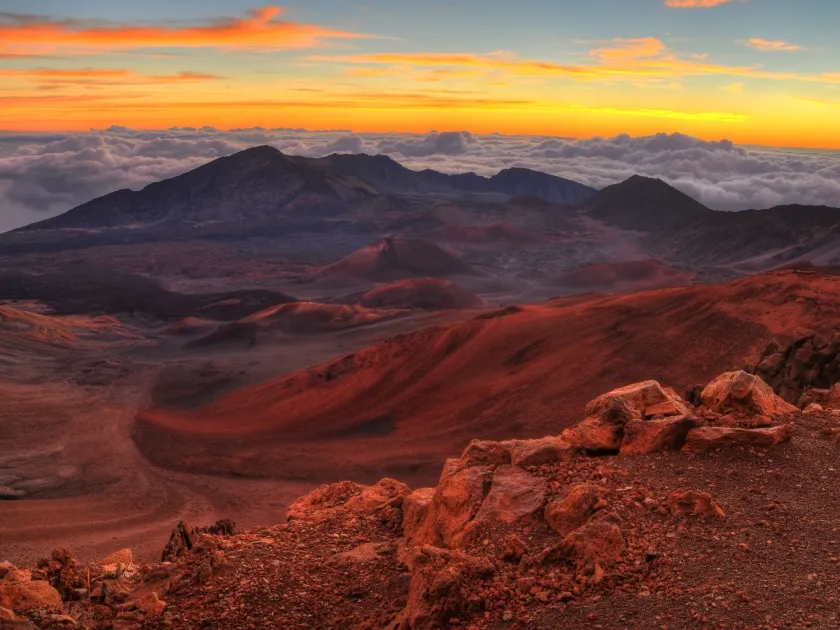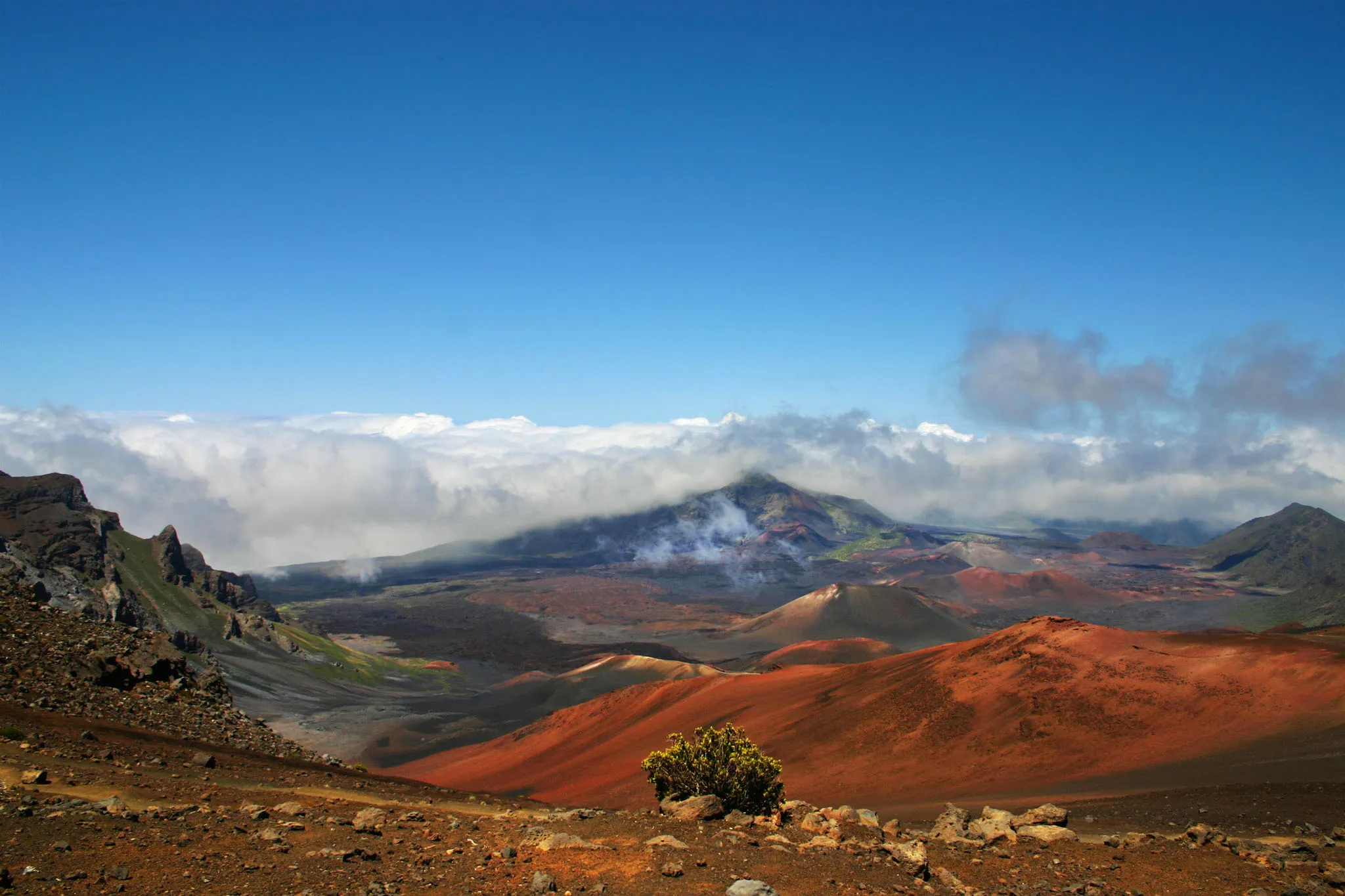Table of Contents
There are few places on Earth where sunrise feels as sacred, surreal, and powerful as it does atop Haleakalā, the “House of the Sun.” Towering 10,023 feet above sea level, this dormant volcano dominates the eastern half of Maui and offers one of the most breathtaking sunrise experiences in the world. For many travelers, watching the Sunrise on Haleakalā’s is not just a highlight of their trip—it’s a spiritual moment, a connection to the island’s natural beauty and deep Hawaiian heritage.
The Meaning of Haleakalā
In Hawaiian, Haleakalā translates to “House of the Sun.” According to Hawaiian legend, the demigod Māui climbed to the summit of this great volcano to capture the sun. The story tells that the sun moved too quickly across the sky, making the days too short. To help his mother, who needed more daylight to dry her kapa (cloth made from bark), Māui lassoed the sun’s rays and made it promise to slow its journey across the sky. The legend gives Haleakalā its name and its enduring connection to the rising sun.
When you stand at the summit as the first golden light spills over the horizon, it’s easy to feel the power of this ancient tale. The moment feels suspended between myth and reality—a perfect balance of cultural reverence and natural wonder.
The Journey to the Summit
Reaching Haleakalā’s summit requires a bit of planning and preparation, but the effort is well worth it. The entrance to Haleakalā National Park is about a 1.5- to 2-hour drive from most resort areas in West or South Maui, depending on traffic and weather. Most visitors begin their journey in the early hours—around 2:30 or 3:00 a.m.—to arrive at the summit in time for sunrise, which generally occurs between 5:30 and 6:30 a.m. depending on the season.
The drive itself is part of the adventure. Winding mountain roads climb steadily upward through eucalyptus forests and pastures, eventually emerging into a lunar-like landscape as you approach the upper slopes. Temperatures drop dramatically as you ascend—sometimes dipping below freezing before dawn—so warm clothing, jackets, and blankets are essential.

Reservation Requirements
Because of the popularity of this iconic experience, the National Park Service requires a sunrise reservation for visitors entering the summit area between 3:00 a.m. and 7:00 a.m. Reservations are available online through the Haleakalā National Park website and often sell out weeks in advance. The $1.50 per vehicle reservation fee is in addition to the regular park entrance fee, which can be paid upon arrival or with a national park pass.
If you aren’t able to secure a reservation, you can still visit later in the day for daytime hiking or return for the Haleakalā sunset, which offers equally stunning views and doesn’t require a special permit.
The Sunrise Experience
Standing above the clouds at more than 10,000 feet, visitors often find themselves surrounded by an ocean of mist as stars sparkle overhead. As the horizon begins to lighten, a deep hush falls over the crowd. Then, slowly, the first rays of sunlight pierce the horizon, casting fiery hues of gold, pink, and orange across the crater and the clouds below.
In that moment, everything feels still—only the sound of the wind and the soft murmur of awe from fellow travelers. The sight is often described as transcendent, evoking a sense of gratitude and connection to something greater than oneself.

It’s no wonder that Native Hawaiians have long regarded Haleakalā as a sacred place. For centuries, it has been a site for ceremony, reflection, and renewal.
What to Bring and How to Prepare
Because conditions at the summit are unique, proper preparation can make the experience far more enjoyable:
- Warm Layers: Temperatures can drop to the 30s or even below freezing before sunrise. Bring a winter jacket, gloves, and hat.
- Flashlight or Headlamp: The parking areas and pathways are very dark before dawn.
- Water and Snacks: The summit facilities are limited, so bring water and light food.
- Camera or Smartphone: The views are extraordinary, but remember to also take time to simply enjoy the moment without a lens.
- Respect the Land: Haleakalā is a sacred space. Show reverence by keeping noise low, staying on marked trails, and avoiding any disturbance to the environment.
Beyond Sunrise: Exploring Haleakalā National Park
After sunrise, many visitors choose to explore the park’s incredible landscapes. The Sliding Sands Trail (Keonehe‘ehe‘e Trail) descends into the crater, offering surreal views of red cinder cones, lava flows, and native plants like the rare ʻāhinahina (silversword). The contrast between the barren volcanic terrain and the lush valleys below showcases the island’s remarkable ecological diversity.
Another option is to drive down to the Kīpahulu District, located near Hāna on Maui’s east side. This coastal section of the park features waterfalls, pools, and rainforests—a lush counterpart to the stark summit above.

A Moment You’ll Never Forget
Witnessing the sunrise from Haleakalā is more than a sightseeing event—it’s an emotional and almost spiritual journey. The mountain’s immense silence, the crisp air, and the slow birth of daylight all combine to create a once-in-a-lifetime memory.
Whether you come for photography, adventure, or quiet reflection, the experience connects you to the heart of Maui—to the spirit of Aloha ʻĀina, the love and respect for the land.
Helpful Links
- Haleakalā National Park Official Website
- Sunrise Reservation Information
- Maui Visitors Bureau – Haleakalā Travel Tips
Frequently Asked Questions
1. Why is sunrise on Haleakalā considered such a special experience?
Sunrise on Haleakalā is often described as sacred and surreal because you’re standing above the clouds at over 10,000 feet, watching the first light spill across a massive volcanic crater. The colors, stillness, and scale of the moment feel almost spiritual. For many visitors, it becomes the highlight of their Maui trip, offering a rare connection to Hawaiian culture and natural beauty.
2. What does the name Haleakalā mean, and why is it important in Hawaiian culture?
“Haleakalā” translates to “House of the Sun.” According to Hawaiian legend, the demigod Māui climbed the mountain to lasso the sun, slowing its journey across the sky so his mother would have more daylight. This story ties the summit directly to the rising sun, giving the sunrise experience deep cultural significance. When you watch the dawn unfold, it's easy to feel the power of this legend.
3. How do I get to the summit of Haleakalā for sunrise?
Reaching the summit requires a 1.5–2 hour drive from most resort areas. Because sunrise happens between 5:30–6:30 a.m., most people leave their hotel around 2:30–3:00 a.m. The drive is part of the adventure—winding roads, steep climbs, and dramatic temperature drops as you ascend into a lunar-like landscape. Warm clothing is essential, as temperatures often dip below freezing before dawn.
4. Do I need a reservation to watch the sunrise on Haleakalā?
Yes. The National Park Service requires a sunrise reservation for any vehicle entering the summit from 3:00 a.m. to 7:00 a.m. Reservations must be made in advance online and often sell out weeks ahead. The cost is $1.50 per vehicle, separate from the standard park entrance fee. If you don’t get a sunrise reservation, you can still enjoy daytime visits or return for sunset—no permit required.
5. What is sunrise on Haleakalā actually like?
It begins in complete darkness under a star-filled sky. As the horizon brightens, the clouds below look like an ocean of mist. Then the sun rises, casting fiery shades of gold, orange, and pink across the crater. The moment is silent, powerful, and emotional—many describe it as a once-in-a-lifetime experience that feels bigger than a typical sightseeing activity.
6. How cold does it get at the summit, and what should I wear?
It can be very cold—temperatures often drop into the 30s or even below freezing before sunrise. Strong winds can make it feel even colder. Bring:
- A heavy jacket
- Gloves and a warm hat
- Thermal layers
- Blankets if available
Being unprepared for the cold is the most common mistake visitors make.
7. What should I bring with me for the Haleakalā sunrise?
Along with warm clothing, bring:
- A flashlight or headlamp for navigating in the dark
- Water and snacks (no food options at the summit)
- A camera or smartphone
- A respectful mindset—Haleakalā is a sacred place
Planning ahead ensures you can fully enjoy the experience.
8. Is the sunrise worth it if I can’t get a reservation?
Yes—because sunset at Haleakalā is just as stunning and does not require a special permit. You’ll still enjoy breathtaking colors across the crater, and the crowds are typically smaller. You can also explore the summit area during the day, hike trails, or return at night for stargazing.
9. What can I do in Haleakalā National Park after sunrise?
Many visitors choose to explore:
- Sliding Sands Trail (Keonehe‘ehe‘e Trail): A hike into the crater’s surreal red cinder cones and volcanic terrain.
- Silversword viewing: Spot the rare ʻāhinahina plant, found only on Haleakalā.
- The Kīpahulu District: Located near Hāna, featuring waterfalls, pools, and lush rainforest landscapes.
The park offers dramatic contrasts—from volcanic desert to coastal jungle.
10. How difficult is the drive back down after sunrise?
The descent can be steep with sharp turns, but it’s manageable if you drive slowly and stay alert. After sunrise, visibility improves, making it easier than the early-morning climb. Just be sure to pull over safely for photos instead of stopping in the road.
11. Why do locals consider Haleakalā a sacred place?
For Native Hawaiians, Haleakalā is tied to cultural stories, ceremonies, and deep spiritual meaning. The summit is a place for reflection, renewal, and honoring the land. Visitors are encouraged to move respectfully—keeping noise low, staying on trails, and leaving no trace.
12. Is sunrise on Haleakalā worth waking up at 2:30 a.m. for?
Almost everyone who experiences it says yes. The combination of natural beauty, cultural meaning, and the feeling of standing above the clouds makes it unforgettable. Whether you’re a photographer, nature lover, or spiritual seeker, the sunrise often becomes one of the most meaningful moments of the entire Maui trip.
If you would like to read and learn more about interesting things in Hawaii! Check out our blog page here on our website!
or
